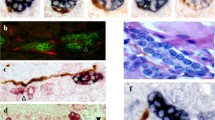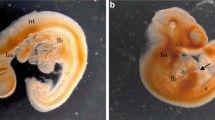Abstract
The aim of the study was to investigate nerve fibers (NF) in human fetal livers. An immunohistochemical study was performed. NF were classified into portal tract innervation (PoI) and parenchymal innervation (PaI). The hilum area showed many Pol NF at 7 GW, and NF increased with gestational week (GW). Direct innervations to biliary epithelium were recognized. In large portal tracts, a few NCAM-positive mesenchymal cells were seen at 8 GW and many mesenchymal cells were noted around 12 GW. Apparent NF emerged around 15 GW, and NF increased with GW. Many NF plexuses were seen in 30–40 GW. In small portal tracts, no NF were seen in 7–10 GW. A few NCAM-positive mesenchymal cells emerged in 11 GW, and they increased thereafter. Apparent NF were seen around 20 GW and NF increased with GW. At term (40 GW), PoI NF were still immature. Ductal plate (DP) was positive for NCAM, NSE, chromogranin and synaptophysin, and direct innervations to DP were seen. The direct innervations to developing bile ducts and peribiliary glands were also seen. PaI NF were first seen at 21 GW and was consistent until 40 GW in which a few NF were seen in PaI. These observations suggest that PoI NF arise from committed portal mesenchyme. PaI NF are very immature at 40 GW. There are direct innervations to bile ducts, peribiliary glands, portal veins, hepatic arteries, and DP.





Similar content being viewed by others
References
Akiyoshi H (1989) Ultrastructure of cholinergic innervation in the cirrhotic liver in guinea pigs. Neurohistochemical and ultrastructural study. Virchow Arch B 57:81–90
Berthoud HR (2004) Anatomy and function of sensory hepatic nerves. Anat Rec 280A:827–835
Bioulac-Sage P, Lafon ME, Saric J, Balabaud C (1990) Nerves and perisinusoidal cells in human liver. J Hepatol 10:105–112
Burt AD, Tiniakos D, MacSween RNM, Griffiths MR, Wisse E, Polak JM (1989) Localization of adrenergic and neuropeptide tyrosine-containing nerves in the mammalian liver. Hepatology 9:839–845
Cassiman D, Denef C, Desmet VJ, Roskams T (2001) Human and rat hepatic stellate cells express neurotrophins and neurotrophin receptors. Hepatology 33:148–158
Cassiman D, Libbrecht L, Sinelli N, Desmet V, Denef C, Roskams T (2002) The vagal nerve stimulates activation of the hepatic progenitor cell compartment via muscarinic acetylcholine receptor 3. Am J Pathol 161:521–530
Cassiman D, Sinelli N, Bockx I et al (2007) Human hepatic progenitor cells express vasoactive intestinal peptide receptor type 2 and receive nerve endings. Liver Int 27:323–328
Delalande JM, Milla PJ, Burns AJ (2004) Hepatic nervous system development. Anat Rec 280A:848–853
Ding WG, Kitasato H, Kimura H (1997) Development of neuropeptide Y innervation in the liver. Microsc Res Tech 15:365–371
El-Salhy M, Stenling R, Grimelius L (1983) Peptidergic innervation and endocrine cells in human liver. Scand J Gastroenterol 28:809–815
Feher E, Fodor M, Gorcs T, Feher J, Vallent K (1991) Immunohistochemical distribution of neuropeptide Y and catecholamine synthesizing enzymes in nerve fibers of the human liver. Digestion 50:194–201
Feher E, Fodor M, Feher J (1992) Ultrastructural localisation of somatostatin- and substance P immunoreactive nerve fibers in the feline liver. Gastroenterology 102:287–294
Goehler LE, Sternini C (1991) Neuropeptide Y immunoreactivity in the mammalian liver: pattern of innervation and coexistence with tyrosine hydroxylase immunoreactivity. Cell Tissue Res 265:287–295
Goehler LE, Sternini C, Brecha NC (1988) Calcitonin gene-related peptide immunoreactivity in the biliary pathway and liver of the guinea pig: distribution and co-localization with substance P. Cell Tissue Res 253:145–150
Jungermann K, Stumpel F (1999) Role of hepatic, intrahepatic and hepatoenteral nerves in the regulation of carbohydrate metabolism and hemodynamics of the liver and intestine. Hepatogastroenterology 46(suppl 2):1414–1417
Lee JA, Ahmed Q, Hines JE, Burt AD (1992) Disappearance of hepatic parenchymal nerves in human liver cirrhosis. Gut 33:87–91
Lin YS, Nosaka S, Amakata Y, Maeda T (1995) Comparative study of the mammalian liver innervation: an immunohistochemical study of PGP 9.5, dopamine-beta-hydroxylase and tyrosine hydroxylase. Comp Biochem Physiol A Physiol 110:289–298
McCuskey RS (2004) Anatomy of efferent hepatic nerves. Anat Rec 280A:821–826
Μiyazawa Y, Fukuda Y, Imoto M, Koyama Y, Nagura H (1988) Immunohistochemical studies on the distribution of nerve fibers in chronic liver diseases. Am J Gastroenterol 83:1108–1114
Nakatani K, Seki S, Kawada N, Kobayashi K, Kaneda K (1996) Expression of neural cell adhesion molecule (N-CAM) in perisinusoidal stellate cells of human liver. Cell Tissue Res 283:159–165
Oben JA, Diehl AM (2004) Sympathetic nervous system regulation of liver repair. Anat Rec 280A:874–883
Oben JA, Roskams T, Yang S et al (2003) Sympathetic nervous system inhibition increases hepatic progenitors and reduces liver injury. Hepatology 38:664–673
Oben JA, Roskams T, Sinelli N et al (2004) Hepatic fibrogenesis requires sympathetic neurotransmitters. Gut 53:438–445
Püschel GP (2004) Control of hepatocyte metabolism by sympathetic and parasympathetic hepatic nerves. Anat Rec 280A:854–867
Roskams T, Cassiman D, De Vos R, Libbrecht L (2004) Neuroregulation of the neuroendocrine compartment of the liver. Anat Rec 280A:910–923
Scoazec JY, Racine L, Couvelard A, Moreau A, Flejou JF, Bernuau D, Feldmann G (1993) Parenchymal innervation of normal and cirrhotic human liver: a light and electron microscopic study using monoclonal antibodies against neural cell-adhesion molecule. J Histochem Cytochem 41:899–908
Terada T, Kawaguchi M (2005) Primary clear cell adenocarcinoma of the peritoneum. Tohoku J Exp Med 271:271–275
Terada T, Nakanuma Y (1987) Solitary cystic dilation of the intrahepatic bile duct: morphology of two autopsy cases and a review of the literature. Am J Gastroenterol 82:1301–1305
Terada T, Nakanuma Y (1988) Morphological examination of intrahepatic bile ducts in hepatolithiasis. Virchows Arch 413:167–176
Terada T, Nakanuma Y (1989) Innervation of intrahepatic bile ducts and peribiliary glands in normal livers, extrahepatic biliary obstruction and hepatolithiasis: an immunohistochemical study. J Hepatol 9:141–148
Terada T, Nakanuma Y (1993a) Development of human peribiliary capillary plexus: a lectin-histochemical and immunohistochemical study. Hepatology 18:529–536
Terada T, Nakanuma Y (1993b) Development of human intrahepatic peribiliary glands: histological, keratin immunohistochemical and mucus histochemical analyses. Lab Invest 68:261–269
Terada T, Nakanuma Y (1994) Profiles of expression of carbohydrate chain structures during human intrahepatic bile duct development and maturation: a lectin-histochemical and immunohistochemical study. Hepatology 20:388–397
Terada T, Nakanuma Y (1995a) Expression of pancreatic enzymes (α-amylase, trypsinogen and lipase) during human liver development and maturation. Gastroenterology 108:1236–1245
Terada T, Nakanuma Y (1995b) Detection of apoptosis and expression of apoptosis-related proteins during human intrahepatic bile duct development. Am J Pathol 146:67–74
Terada T, Nakanuma Y, Ohta G (1987) Glandular elements around the intrahepatic bile ducts in man: their morphology and distribution in normal livers. Liver 7:1–8
Terada T, Ishida F, Nakanuma Y (1989) Vascular plexus around intrahepatic bile ducts in normal livers and portal hypertension. J Hepatol 8:139–149
Terada T, Okada Y, Nakanuma Y (1995) Expression of matrix proteinases during human intrahepatic bile duct development: a possible role in biliary cell migration. Am J Pathol 147:1207–1213
Terada T, Kitamura Y, Nakanuma Y (1997a) Normal and abnormal development of the intrahepatic biliary system: a review. Tohoku J Exp Med 181:19–32
Terada T, Kitamura Y, Ohta T, Nakanuma Y (1997b) Endocrine cells in hepatobiliary cystadenoma and cystadenocarcinoma. Virchows Arch 430:37–40
Terada T, Ashida K, Kitamura Y et al (1998) Expression of E-cadherin, alpha-catenin and beta-catenin during human intrahepatic bile duct development. J Hepatol 28:263–269
Terada T, Kawaguchi M, Furukawa K, Sekido Y, Osamura Y (2002) Minute mixed ductal-endocrine carcinoma of the pancreas with predominant intraductal growth. Pathol Int 52:740–746
Tiniakos DG, Mathew J, Kittas C, Burt AD (2008) Ontogeny of human intrahepatic innervation. Virchows Arch 452:435–442
Ueno T, Tanikawa K (1996) Intralobular innervation and lipocyte contractility in the liver. Nutrition 13:141–148
Ueno T, Inuzuka S, Torimura T et al (1991) Distribution of substance P and VIP in the human liver. Am J Gastroenterol 86:1633–1637
Ueno T, Bioulac-Sage P, Balabaud C, Rosenbaum J (2004) Innervation of the sinusoidal wall: regulation of the sinusoidal diameter. Anat Rec 280A:868–873
Conflict of interest
The author has no conflict of interest.
Author information
Authors and Affiliations
Corresponding author
Rights and permissions
About this article
Cite this article
Terada, T. Ontogenic development of nerve fibers in human fetal livers: an immunohistochemical study using neural cell adhesion molecule (NCAM) and neuron-specific enolase (NSE). Histochem Cell Biol 143, 421–429 (2015). https://doi.org/10.1007/s00418-014-1286-y
Accepted:
Published:
Issue Date:
DOI: https://doi.org/10.1007/s00418-014-1286-y




